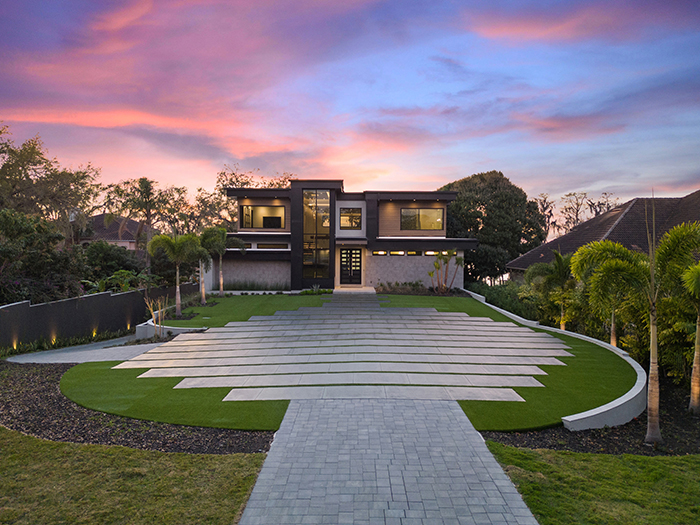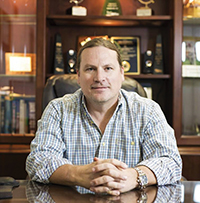
Lake Sheen Showcase is a solar-powered smart home with numerous home automation technologies. This home, and all others in Manor, are by Hardwick General Contracting.
GETTING COMFY WITH TECHNOLOGY
 We live in a world where technology has made its way into almost every aspect of our lives — including our homes. For some, it makes life easier; for others, more challenging. Anyone who has ever struggled to figure out a streaming service knows that our homes are the last places we want technology to frustrate us.
We live in a world where technology has made its way into almost every aspect of our lives — including our homes. For some, it makes life easier; for others, more challenging. Anyone who has ever struggled to figure out a streaming service knows that our homes are the last places we want technology to frustrate us.
Greg Hardwick, founder and president/owner of Hardwick General Contracting in Maitland, has been building high-end luxury houses for 20 years. And over those two decades, technology and automation have become major elements of the home design process.
“We work very hard to match the level of technology with the expectations of the owner,” says Hardwick, who as a professional engineer is comfortable in the burgeoning home-technology arena.
One of the first things Hardwick does when he meets with clients to discuss the design process is to conduct a “lifestyle assessment” on their level of home-technology expectations.
“We’re very careful not to push home technology and automation beyond what customers are actually looking for to make their lifestyles more convenient,” says Hardwick, whose custom homes usually range in size from 6,000 to 12,000 square feet and are priced from $2 million.
High-tech options he offers may range from a few WiFi dimmers controlled via an app to lighting and shade automation matched to circadian rhythms — which in essence are the physical, mental and behavioral changes an organism (including humans) experiences over a 24-hour cycle.
HOME ILLUMINATION
The discussion starts with lighting control. Buyers want the convenience of being able to turn off the majority of lights in the home without having a wall stacked with five or six switches. Cleaner walls, minus switches, add aesthetic appeal to a custom home, Hardwick points out. Buyers also want to use artificial lighting to set the scene, which is different in the morning, the afternoon and the evening — when you may be entertaining guests over dinner or watching a movie with the family.
When it comes to natural light in the home, shading is important — and many buyers favor automated draperies and window shades. At this point, Hardwick says, a basic lighting control package addressing the treatment of both artificial and natural light is designed.
Says Hardwick: “If a client says to me, ‘Wow this is great stuff, Greg, let’s keep going,’ then we start talking about circadian rhythm in lighting, which is still kind of on the cutting-edge of lighting technology.”
Hardwick admits that even some of his most knowledgeable buyers will only opt for circadian rhythm lighting in limited areas, usually in the bedroom, the living and common areas.
“You can actually program the light to emulate the sun as it passes over the property,” he notes. “In the morning, you can get those warmer yellow wake-up colors, sunrise-type colors.”
The lighting is controlled to match the sun as it moves closer to being directly overhead and when it gradually comes down as sunset approaches — all in an effort to complement your biological clock.
AUTOMATION BEYOND LIGHTING
From lighting automation, Hardwick takes clients through other more basic requests. WiFi and controllable thermostats, for example, are long-established technologies and may be found in pretty much every home built over the past decade.
There’s also the ability to control appliances, air conditioning, garage doors and plumbing fixtures. Hardwick says that he finds that there’s a wide range of appetites for home technology from one buyer to another.
The question is: How far do you want to go? Many buyers, says Hardwick, also request controlled lighting to some extent, particularly in the kitchen, dining room, family room, entertainment area, master bedroom and perhaps outdoor living areas connected to the house.
Notes Hardwick: “Generally it becomes, ‘OK, I’m controlling my lights and now I have all these other internet-connected devices. How do I control those without several different apps?’”
The next step, then, is to find the right home-automation platform that enables buyers to do all the things they feel comfortable controlling remotely. Devices can all be integrated into a single platform, says Hardwick, meaning no multiple devices to keep up with.
When clients aren’t ready to go all in, technology wise, Hardwick says he tries to “future-proof” the house as much as possible by providing wired internet connections in every room where there may be a need later on.
“This allows homeowners to add more technology at a slower pace when they’re ready,” he adds.
PROVIDERS & TECH GURUS
Obviously, using all this technology is going to rely on the strength of the buyer’s internet-service provider. But there are always outages regardless, which is why everything is programmed to still work even without the internet.
“Generally, we design a lot of these things so that if the internet is down, you can still turn your lights on, watch TV and continue to do all these things,” says Hardwick. “So if your main internet connection goes down, there’s a way to swap over to a cellular network.”
A home can even be wired to go use satellite technology for people who really want to maintain functionality no matter what.
The higher you climb on the home-technology scale, the more you’ll need a third-party lighting technician or home- technology guru. Hardwick encourages hiring a professional, especially when you’re spending at least $500,000 on technology alone.
The more complex the technology the more likely you are to make a costly mistake that a specialist could have helped you avoid. Plus, a specialist may recommend new solutions or products that aren’t yet widely used. Hardwick has a list for his buyers that includes top professionals from across the country.
As technology and automation in homebuilding continues to forge ahead, Hardwick General Contracting is staying on the leading edge to meet demands now and years from now.
